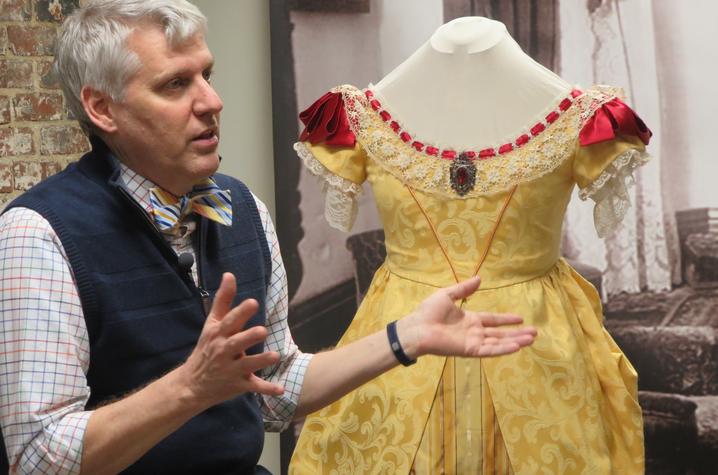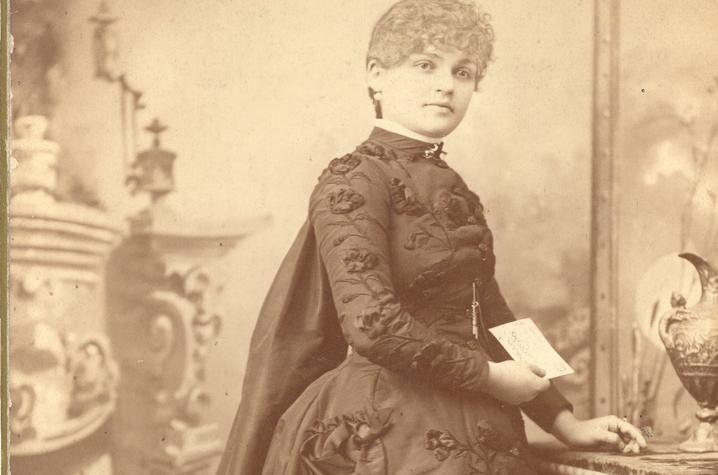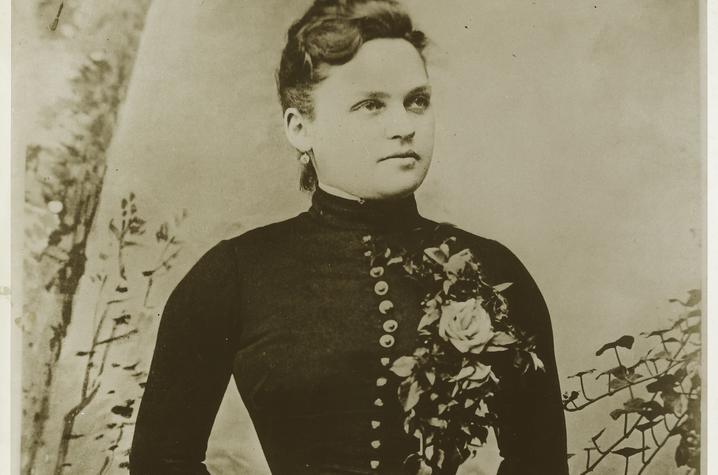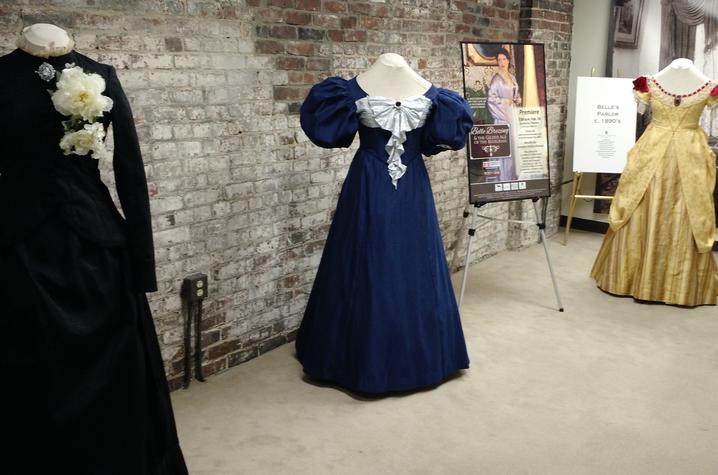Dressing Lexington's Most Notorious Madam
Video produced by UK Public Relations and Marketing. To view captions for this video, push play and click on the CC icon in the bottom right hand corner of the screen. If using a mobile device, click on the "thought bubble" in the same area.
LEXINGTON, Ky. (Feb. 10, 2017) — Next week, one of Lexington's most notorious citizens will get her moment on the big screen as Kentucky Theatre debuts a new one-hour documentary on Belle Brezing. Helping bring the story of this infamous madam to life is University of Kentucky's own Nelson Fields, associate professor of theatre and dance, who served as costume designer and associate producer of "Belle Brezing and the Gilded Age of the Bluegrass."
Few individuals in the history of the Commonwealth of Kentucky are as controversially remembered and celebrated today as Belle Brezing. A Lexington madam, Brezing had a nationwide reputation for running the Victorian era's “most orderly of dis-orderly homes.” With a head for business in the business of sex, Brezing's story is deeply woven into the tapestry of Lexington's Gilded Age. It is believed the Bluegrass' booming equine industry grew to new heights in her influential parlor as a world class clientele visited Brezing and her ladies from the end of the 19th century through the start of World War I.
"Belle Brezing and the Gilded Age of the Bluegrass," produced by High Impact Productions for public television, shines a spotlight once again on the amazing life of a Lexington icon who even Time magazine reported the death of in 1940. Using interviews with celebrated authors and historians and archival images from Brezing's life digitized by UK Special Collections Research Center and available online at ExploreUK, the film details her journey from a bleak youth to the Baroness of the Brothel, while becoming the inspiration for the character of Belle Watling in "Gone with the Wind."
Recent interest in Brezing surged with the publication of "Madam Belle: Sex, Money, and Influence in a Southern Brothel" by author and UK history alumna Mary Jean Wall and published by University Press of Kentucky.
"This new book by Maryjean Wall is kind of what sparked the interest in it. What she seemed to do that the other researchers did not do, was that she really talked about Lexington during the period and the horse industry and how well connected this woman was to the horse industry. And I think that brought a new aspect to the story that hadn't really been considered before," said Fields, who believes the documentary focuses as much on Lexington during this Gilded Age as Brezing.
To accompany the interviews and bring Brezing and Lexington's story to life, director Doug High and his cast and crew, weaved in reenactments of the time starring UK theatre alumna Laurie Genet Preston, who previously played the madam in Margaret C. Price's "Belle Brezing."
For those reenactments to work, Fields used his expertise of the era and research to make Preston and the other actors look the part in costumes that range from 1880 to 1910. But unlike plays and opera, which he works with regularly at UK, Fields did not have a script to work from. Instead he worked from scenarios for various scenes High wanted to shoot.
"First day, I kind of had to go with I knew we were shooting in this Victorian parlor setting and I just took a lot of different things. I knew he (High) wanted a dressing gown look for her, he wanted an evening gown look, and I kind of threw in this day dress look, which I'm glad I did," said Fields.
Fields' work on the documentary came as much on set as it did in his studio and costume shop. For that first day of filming, extra accessories saved the day when Fields created a fourth look on set using a hat, purse and gloves, as a scene with a storefront was added to the day of filming. He also reworked the evening dress on site as he became familiar with how different the looks appeared on camera versus the stage, his usual platform.
"When I got there, the evening gown that I had brought for her had all this trim on it and I was like this is not going to work, so I was over there ripping trim off of it to try to get it to where it would look good on camera. It was almost like improvisation in some ways," Fields said.
Cognizant of Brezing's success in a time before women had the right to vote and when very few owned businesses, Fields also endeavored to show her in a variety of looks that did not play up the madam angle of her story. So in addition to evening wear for entertaining, he created a look for a business woman using a shirtwaist and tie from that period and crafted clothes that she would likely wear when shopping or running errands around Lexington, pieces that were "a little bit flamboyant but not out of the realm of possibility for the period."
The concepts for Fields' garments came from two types of research. "There's what I call inspirational research where I'm looking for images that aren't going to tell me anything about the clothing. In this case, fortunately, University of Kentucky's Special Collections has almost all these images that have survived from her house. So I started there, looking at images of her, images of her house, and a lot of images of people who were obviously in her life but they don't know who they are. So you can kind of get some sense of who she was from those people.
"Then I started looking through primary research for images of clothing of the period. This period is easy because with the internet it's so easy to access that information. You can go to virtually any museum in the world that has clothing collections and you can access the images. But I'm also trying to find images of the people in this clothing. She's (Belle's) not wearing a Worth gown from Paris, so you're looking for clothing that will fit in this community that would make sense. Fashion and illustration images that they might have seen and might have said to a dressmaker, 'I like this, can you make this for me?' That would be a very common way things would get made in that time. So I was looking at fashion illustrations, Harper's Bazaar, Godey's Lady's Book, for those kinds of images, but then on the second day, I'm looking for images of men. I looked at some artwork. One of the best looks I looked at was Charles Dana Gibson, the one who created the Gibson girl in the late 19th century."
Another inspiration for his work in the documentary, may be noticeable to fans of cinema. For one scene, where Brezing opens her third and final brothel, Fields needed a dress that would fit in with the celebration but also stand out in the room. He found inspiration for this dress from a character in film.
"I started thinking back to 'Gone with the Wind' and the character of Belle Watling, who now we know is based on Brezing. And I thought back to Ona Munson in the film, the scene where she was there in this striking gold dress with the scarlet trim. It was a jolt — because I know that color combination was very popular during the Victorian period. I've seen it in a number of fashion illustrations described that the dress was gold with scarlet trim and I even read that in researching years before that the color combination was very popular.
"So I realized that the designer in 'Gone with the Wind,' Walter Plunkett, had seen some of the same research and used that. And I thought, why not use that color combination. It's appropriate to the period, it pays homage to that film and to that design. I didn't want to copy it, it wasn't a copy of that dress by any means. But when you see her in the pictures with the other girls, she is the most important thing in the room and it worked out really beautifully. So, in this instance, the solution just kind of walked in and sat down and said here I am. It worked out great," Fields said.
To successfully design approximately 20 costumes for the documentary and still carry out his classes in costume design and stage make-up; do his costume work on the dance concert and "Once on this Island" production for UK Department of Theatre and Dance and UK Opera Theatre's "The Barber of Seville"; and work on research on tailoring with an author in England and the documentation of sewing patterns, Fields asked one of his talented students to work with him on the Brezing project. Ian Witten, a theatre senior from Mackville, Kentucky, who had classes with Fields and worked in UK's Costume Shop was eager to help.
"This has been a really fun learning experience. I've learned a little about Belle and Lexington at the time. Even though I'm close to this area, a lot of my family is from Louisville, so I haven't been a part of the Lexington history scene," Witten said.
As part of the team working on the documentary, Witten helped Fields with fittings and any changes that needed to be done. At the shoots, he loaded in and out costumes, and helped actors get dressed. Witten then stayed on set helping with whatever alterations that were needed.
In addition, Witten was able to develop new skills helping problem solve costuming for film, since his background so far at UK has been costuming for the stage. As he approaches his career, he now knows firsthand what to look for in a set environment too, including the tiniest of wrinkles that show on the garment on film.
Witten, who is also doing an independent study in tailoring with Fields, is proud of the work he has done for UK Theatre and the Brezing documentary, and enjoys seeing his work in action. "I really enjoy building and creating costuming, and theater and film has given me that option. I get to say 'I built that,' and it's really great to see something that you've built be used for bigger and better things."
Audiences will have their first chance to see "Belle Brezing and the Gilded Age of the Bluegrass" at 7:30 p.m. Thursday, Feb. 16, at the Kentucky Theatre. Tickets are $8 and can be purchased online here or in person at the theater. A premiere party will be held in celebration of the documentary at 5:30 p.m. that evening at Portofino. Individuals attending the party will be able to meet and mingle with documentary executive producer/director Doug High, who is also a news anchor on "Good Morning Kentucky" on WTVQ-TV ABC 36, and the historians featured in the documentary: Maryjean Wall, author of "Madam Belle"; Doug Tattershall, author of "Belle Brezing: American Magdalene"; and Foster Ockerman Jr., author of "Historic Lexington, Heart of the Bluegrass." Tickets for the party, including drinks, hors d'oeuvres and a ticket to the documentary premiere, can be purchased online here through Feb. 13. Proceeds from the tickets will benefit Lexington History Museum.
In addition to the showing at the Kentucky Theatre, the documentary will be presented in Frankfort at the Thomas D. Clark Center for Kentucky History and on KET. For more information on where to see this documentary, visit www.facebook.com/BelleBrezingDocumentary/.
The UK Department of Theatre and Dance at UK College of Fine Arts has played an active role in the performance scene in Central Kentucky for more than 100 years. Students in the program get hands-on training and one-on-one mentorship from the renowned professional theatre faculty. The liberal arts focus of their bachelor's degree program is coupled with ongoing career counseling to ensure a successful transition from campus to professional life.








